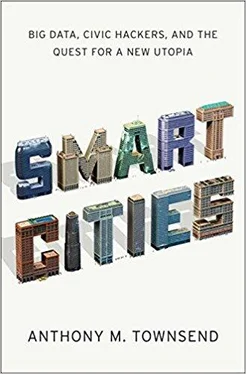“It arrived at the exact period when it was needed for the organization of great cities and the unification of nations.”
For anyone who has telecommuted to work or watched a live broadcast from the other side of the planet, it seems counterintuitive that the growth of cities and the spread of information technology are so strongly linked. Many have argued the opposite—that new technologies undermine the need for cities and all of the productive yet expensive and sometimes unpleasant proximity they provide. In 1964 science-fiction legend Arthur C. Clarke articulated a vision of the future where, thanks to satellite communications, “It will be possible ... perhaps only fifty years from now, for a man to conduct his business from Tahiti or Bali, just as well as he could from London.”24 More recently, as the Internet began its meteoric rise in the mid-1990s, tech pundit George Gilder wrote off cities as “leftover baggage from the industrial era.”25 But instead of disintegrating, London grew bigger, richer, more vital and connected than ever. Instead of undermining the city, new telecommunications technologies played a crucial role in London’s success—it is the hub of a global tangle of fiber-optic networks that plug its financiers and media tycoons directly into the lives of billions of people all over the world.
We experience the symbiosis of place and cyberspace every day. It’s almost impossible to imagine city life without our connected gadgets. In my own pocket, I carry an iPhone. It is my megacity survival kit, a digital Swiss Army knife that helps me search, navigate, communicate, and coordinate with everyone and everything around me. I have apps for finding restaurants, taxis, and my friends. A networked calendar keeps me in sync with my colleagues and my family. If I’m running late, there are three different ways to send a message and buy some time. But I’m not alone. We’ve all become digital telepaths, hooked on the rush we get as these devices untether us from the tyranny of clocks, fixed schedules, and prearranged meeting points. The addiction started, as all do, slowly at first. But now it governs the metabolism of our urban lives. With our days and nights increasingly stretched across the vastness of megacities, we’ve turned to these smart little gadgets to keep it all synchronized. It’s no accident that the most common text message, sent billions of times a year all over the world, is “where are you?”
The digital revolution didn’t kill cities. In fact, cities everywhere are flourishing because new technologies make them even more valuable and effective as face-to- face gathering places.
Struggle
Beginning in the 1930s, men like Robert Moses began rebuilding cities around a new technology, the automobile. Moses was an autocrat and technocrat, a master planner and “power broker” (the title of Robert Caro’s epic biography). His disdain for the accumulated architectural canvas he inherited was no secret. “You can draw any kind of picture you like on a clean slate and indulge your every whim in the wilderness of laying out a New Delhi, Canberra or Brasilia,” he said of the new capital cities of that era, “but when you operate in an overbuilt metropolis you have to hack your way with a meat ax” For three decades, in various public posts in New York and elsewhere as a consultant, Moses brought to life the dazzling vision of a middle-class, motorized America first unveiled by General Motors at the 1939 Worlds Fair in New York City. To make way for the future, he bulldozed the homes of over a quarter-million unfortunate New Yorkers.
Today, a new group of companies have taken GM’s spot in the drivers seat and are beginning to steer us toward a new utopia, delivered not by road networks but by digital networks. Instead of paving expressways through vibrant neighborhoods, these companies hope to engineer a soft transformation of cities through computing and telecommunications. “Drivers now see traffic jams before they happen,” boasts an IBM advertisement posted in airports all over the world. “In Singapore, smarter traffic systems can predict congestion with 90% accuracy.” With upgrades like these, unlike Moses, we may never need to pave another mile of roadway.
For the giants of the technology industry, smart cities are fixes for the dumb designs of the last century to prepare them for the challenges of the next, a new industrial revolution to deal with the unintended consequences of the first one. Congestion, global warming, declining health—all can simply be computed away behind the scenes. Sensors, software, digital networks, and remote controls will automate the things we now operate manually. Where there is now waste, there will be efficiency. Where there is volatility and risk, there will be predictions and early warnings. Where there is crime and insecurity, there will be watchful eyes. Where you now stand in line, you will instead access government services online. The information technology revolution of the nineteenth century made it possible to govern industrial cities as their population swelled into the millions. This revolution hopes to wrest control over cities of previously unthinkable size—ten, twenty, fifty, or even one hundred million people.
With a potential market of more than $100 billion through the end of this decade, many of the worlds largest companies are jockeying for position around smart cities. There are the engineering conglomerates that grew to greatness building the systems that control our world: IBM, which sprang from the company that built the tabulators for the 1890 census; Siemens, which got its start by wiring up German cities with telegraph cables; and General Electric, which lit up Americas cities with artificial light. But there are newcomers, too, like Cisco Systems, the master plumber of the Internet. For each, success in selling us on smart cities will pave the way for decades of growth. Peering out from the cover of Forbes in 2011, CEO Peter Loscher of Siemens summed up the hopes of corporate leaders everywhere as he gushed at the prospect of supplying infrastructure for the cities of the developing world, “This is a huge, huge opportunity.”
By the 1970s, the construction of urban expressways in the United States had ground to a halt, stopped by a grassroots rebellion that held very different views of the role of cars, how city planning should be conducted, and even the very nature of the city itself. The first signs of a similar backlash to corporate visions of smart cities are now coming to light, as a radically different vision of how we might design and build them bubbles up from the street. Unlike the mainframes of IBM’s heyday, computing is no longer solely in the hands of big companies and governments. The raw material and the means of producing the smart city—smartphones, social software, open-source hardware, and cheap bandwidth—are widely democratized and inexpensive. Combining and recombining them in endless variations is cheap, easy, and fun.
All over the world, a motley assortment of activists, entrepreneurs, and civic hackers are tinkering their ways toward a different kind of utopia. They eschew efficiency, instead seeking to amplify and accelerate the natural sociability of city life. Instead of stockpiling big data, they build mechanisms to share it with others. Instead of optimizing government operations behind the scenes, they create digital interfaces for people to see, touch, and feel the city in completely new ways. Instead of proprietary monopolies, they build collaborative networks. These bottom-up efforts thrive on their small scale, but hold the potential to spread virally on the Web. Everywhere that industry attempts to impose its vision of clean, computed, centrally managed order, they propose messy, decentralized, and democratic alternatives. It’s only a matter of time before they come to blows.
Читать дальше












